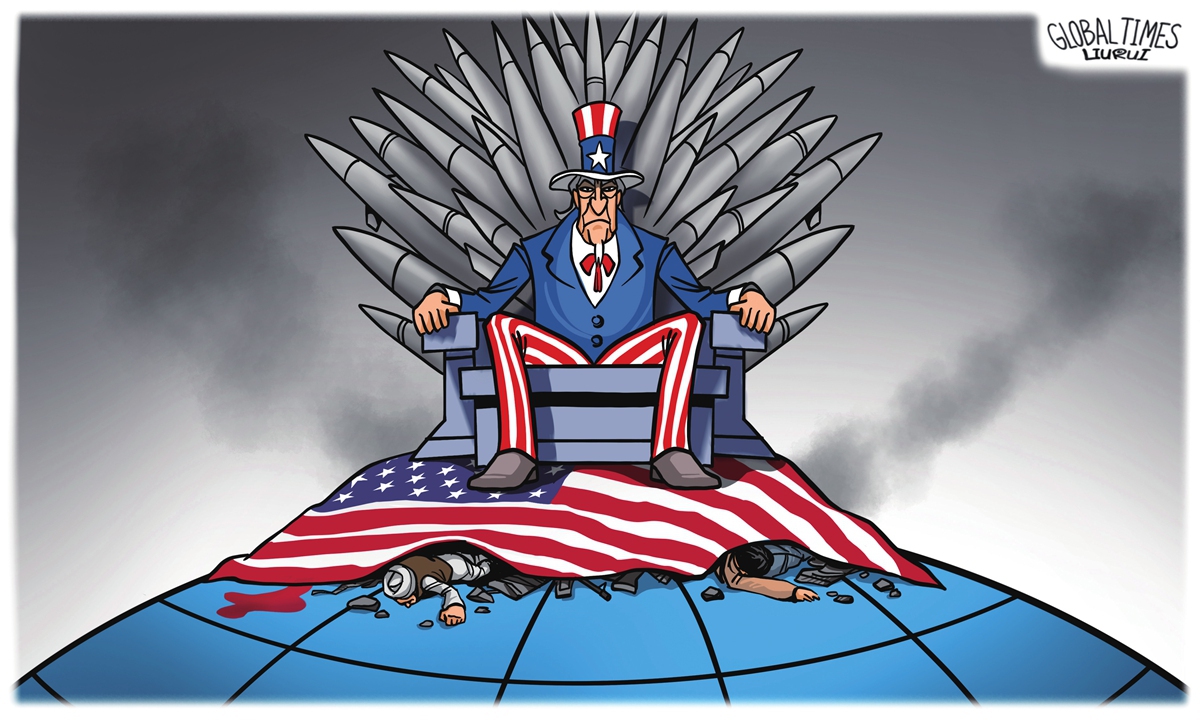
House of Hegemony Illustration: Liu Rui/GT
Mainly in the consideration of coping with the protracted Russia-Ukraine conflict and containing China's economic rise, the US and its NATO allies are in increasing discussions on rebuilding the defense industry.The US military industry mainly rose during World War II and the Cold War. After the outbreak of the Pearl Harbor blitz attack in 1941, the US completed the wartime mobilization of the US economy in only six months, transformed a large number of civilian industrial enterprises into military industrial complex. This puts the US military-industrial complex on the historic stage.
During the Cold War, the US military expenditure accounted for a very high proportion of its GDP. At its peak in 1967, US military spending reached 9.42 percent of GDP. Huge military expenditure nourished a flourishing military industry expansion, leading to a huge new type of interest group, which plays a pivotal role in the national economy and the country's political life.
After the end of the Cold War, countries generally turned to peaceful development. US military spending as a percentage of GDP has declined accordingly. The military economic system was naturally impacted. The decline in the procurement of military equipment has led to the transformation of many US military enterprises to civilian use, and some firms just went bankrupt.
Since the end of the Cold War, under the guidance of the narrative of globalization, the global economy has entered a new era of profit maximization. A large number of American manufacturing companies moved outward, and the concept of military-industrial complex during the Cold War has gradually been replaced by the new concept of financial-military-industrial complex. The US has transferred the low-value-added links in the military production chain to foreign countries, and the proportion of international procurement has continued to rise.
This has led to the fact that some raw materials and components in the US military production need to be purchased from many other countries, including China. In 2017, the US launched a series of key mineral security initiatives, strategies and lists. Among the 35 key minerals included in the list, the top producers of 19 are located in China, accounting for more than 50 percent.
Meanwhile, the dependence of US military enterprises on the international consumer market has increased. US military giant Lockheed Martin generated $65.984 billion in revenue in 2022, 26 percent of which came from international customers. The US has produced nearly 5,000 F-16 fighters, more than half of which are produced for other countries and regions.
The upper and lower ends of the US military industry chain are both heavily dependent on the international market, and are on the road to internationalization like other industries. This is a normal phenomenon and one of the inevitable results of the process of globalization. But now, the US and the entire Western camp have new consideration for their military industry, mainly based on two reasons:
First, as the US keep escalating tensions with China, the industrial interdependence between the US and China - an important source of raw materials for the US military industry - are being undermined to a certain extent.
Second, the conflict between Russia and Ukraine is unlikely to come to an end at short notice, and the demand for military equipment has exceeded expectations. This made the US realize that although the qualitative advantages of high-tech weapon systems can win some small battles, they are not enough to overwhelm the quantitative advantages of a military power. In a war scenario where the military power is the imaginary enemy, the US military not only needs to lead in quality, but also cannot lag behind in quantity.
The outbreak of the Russia-Ukraine conflict has brought business opportunities for the US military industry. In 2022, European military spending reached the highest level since the end of the Cold War at $480 billion, an increase of 13 percent over the previous year. US military spending has also risen year after year. In March 2023, the White House announced the budget for fiscal year 2024, planning to allocate $842 billion to the US Department of Defense, a year-on-year increase of 3.2 percent. This is the highest military budget ever proposed by the US government. A considerable part of US and European military expenditures has become new orders for US military enterprises.
The US' renewed emphasis on military production is not merely an emergency response to the Russia-Ukraine conflict. On the one hand, the US has major strategic intentions. During the Reagan administration, the US used an arms race to cripple the Soviet Union economically. Many Americans believe that increasing military expenditures to bring down strategic opponents is cheaper than launching a war. On the other hand, this will have a serious impact on the strategic balance and peace in the post-Cold War era. There is a balance between the US and other major powers for a long time: the US had a qualitative advantage in military power, but no obvious quantitative advantage. This balance makes the US and other major powers unable to launch large-scale wars, thus forming a kind of strategic mutual trust among major powers. Once the US military seeks to improve its quantitative disadvantage while possessing a qualitative advantage, the result will be an even more intense arms race, and damage the already fragile relationship with other major powers. This will increase the risk of war, which is not good news for world peace and stability.
The author is a professor with the Center for American Studies at Fudan University.






